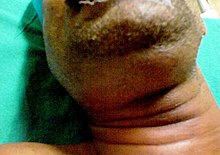| Ludwig's angina | |
|---|---|
| Other names | Angina Ludovici |
 | |
| Swelling in the submandibular area in a person with Ludwig's angina. | |
| Specialty | Otorhinolaryngology, oral and maxillofacial surgery |
| Symptoms | Fever, pain, a raised tongue, trouble swallowing, neck swelling[1] |
| Complications | Airway compromise[1] |
| Usual onset | Rapid[1] |
| Risk factors | Dental infection[1] |
| Diagnostic method | Based on symptoms and examination, CT scan[1] |
| Treatment | Antibiotics, corticosteroids, endotracheal intubation, tracheostomy[1] |
Ludwig's angina (Latin: Angina ludovici) is a type of severe cellulitis involving the floor of the mouth[2] and is often caused by bacterial sources.[1] Early in the infection, the floor of the mouth raises due to swelling, leading to difficulty swallowing saliva. As a result, patients may present with drooling and difficulty speaking.[3] As the condition worsens, the airway may be compromised and hardening of the spaces on both sides of the tongue may develop.[4] Overall, this condition has a rapid onset over a few hours.
The majority of cases follow a dental infection.[3] Other causes include a parapharyngeal abscess, mandibular fracture, cut or piercing inside the mouth, or submandibular salivary stones.[5] The infection spreads through the connective tissue of the floor of the mouth and is normally caused by infectious and invasive organisms such as Streptococcus, Staphylococcus, and Bacteroides.[6]
Prevention is by appropriate dental care including management of dental infections. Initial treatment is generally with broad-spectrum antibiotics and corticosteroids.[1] In more advanced cases endotracheal intubation or tracheostomy may be required.[1]
With the advent of antibiotics in 1940s, improved oral and dental hygiene, and more aggressive surgical approaches for treatment, the risk of death due to Ludwig's angina has significantly reduced. It is named after a German physician, Wilhelm Frederick von Ludwig, who first described this condition in 1836.[7]
- ^ a b c d e f g h i Gottlieb, M; Long, B; Koyfman, A (May 2018). "Clinical Mimics: An Emergency Medicine-Focused Review of Streptococcal Pharyngitis Mimics". The Journal of Emergency Medicine. 54 (5): 619–629. doi:10.1016/j.jemermed.2018.01.031. PMID 29523424.
- ^ Cite error: The named reference
Candamourty_20122was invoked but never defined (see the help page). - ^ a b Coulthard P, Horner K, Sloan P, Theaker ED (2013-05-17). Master dentistry (3rd ed.). Edinburgh: Elsevier. ISBN 978-0-7020-4600-1. OCLC 786161764.
- ^ Kremer MJ, Blair T (December 2006). "Ludwig angina: forewarned is forearmed". AANA Journal. 74 (6): 445–51. PMID 17236391.
- ^ Saifeldeen K, Evans R (March 2004). "Ludwig's angina". Emergency Medicine Journal. 21 (2): 242–3. doi:10.1136/emj.2003.012336. PMC 1726306. PMID 14988363.
- ^ The atlas of emergency medicine. Kevin J. Knoop, Lawrence B Stack, Alan B Storrow, R. Jason Thurman (Fifth ed.). New York. 2021. ISBN 978-1-260-13495-7. OCLC 1145903874.
{{cite book}}: CS1 maint: location missing publisher (link) CS1 maint: others (link) - ^ Murphy SC (October 1996). "The person behind the eponym: Wilhelm Frederick von Ludwig (1790-1865)". Journal of Oral Pathology & Medicine. 25 (9): 513–5. doi:10.1111/j.1600-0714.1996.tb00307.x. PMID 8959561.